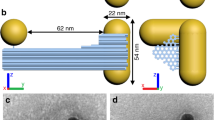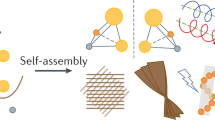Abstract
Matter structured on a length scale comparable to or smaller than the wavelength of light can exhibit unusual optical properties1. Particularly promising components for such materials are metal nanostructures, where structural alterations provide a straightforward means of tailoring their surface plasmon resonances and hence their interaction with light2,3. But the top-down fabrication of plasmonic materials with controlled optical responses in the visible spectral range remains challenging, because lithographic methods are limited in resolution and in their ability to generate genuinely three-dimensional architectures4,5. Molecular self-assembly6,7 provides an alternative bottom-up fabrication route not restricted by these limitations, and DNA- and peptide-directed assembly have proved to be viable methods for the controlled arrangement of metal nanoparticles in complex and also chiral geometries8,9,10,11,12,13,14. Here we show that DNA origami15,16 enables the high-yield production of plasmonic structures that contain nanoparticles arranged in nanometre-scale helices. We find, in agreement with theoretical predictions17, that the structures in solution exhibit defined circular dichroism and optical rotatory dispersion effects at visible wavelengths that originate from the collective plasmon–plasmon interactions of the nanoparticles positioned with an accuracy better than two nanometres. Circular dichroism effects in the visible part of the spectrum have been achieved by exploiting the chiral morphology of organic molecules and the plasmonic properties of nanoparticles18,19,20, or even without precise control over the spatial configuration of the nanoparticles12,21,22. In contrast, the optical response of our nanoparticle assemblies is rationally designed and tunable in handedness, colour and intensity—in accordance with our theoretical model.
This is a preview of subscription content, access via your institution
Access options
Subscribe to this journal
Receive 51 print issues and online access
$199.00 per year
only $3.90 per issue
Buy this article
- Purchase on Springer Link
- Instant access to full article PDF
Prices may be subject to local taxes which are calculated during checkout




Similar content being viewed by others
References
Liu, Y. & Zhang, X. Metamaterials: a new frontier of science and technology. Chem. Soc. Rev. 40, 2494–2507 (2011)
Barnes, W. L., Dereux, A. & Ebbesen, T. W. Surface plasmon subwavelength optics. Nature 424, 824–830 (2003)
Polman, A. Plasmonics applied. Science 322, 868–869 (2008)
Soukoulis, C. M. & Wegener, M. Past achievements and future challenges in the development of three-dimensional photonic metamaterials. Nature Photon. 5, 523–530 (2011)
Gansel, J. K. et al. Gold helix photonic metamaterial as broadband circular polarizer. Science 325, 1513–1515 (2009)
Jones, M. R., Osberg, K. D., Macfarlane, R. J., Langille, M. R. & Mirkin, C. A. Templated techniques for the synthesis and assembly of plasmonic nanostructures. Chem. Rev. 111, 3736–3827 (2011)
Fan, J. A. et al. Self-assembled plasmonic nanoparticle clusters. Science 328, 1135–1138 (2010)
Seeman, N. C. Nanomaterials based on DNA. Annu. Rev. Biochem. 79, 65–87 (2010)
Tan, S. J., Campolongo, M. J., Luo, D. & Cheng, W. Building plasmonic nanostructures with DNA. Nature Nanotechnol. 6, 268–276 (2011)
Ding, B. et al. Gold nanoparticle self-similar chain structure organized by DNA origami. J. Am. Chem. Soc. 132, 3248–3249 (2010)
Mastroianni, A. J., Claridge, S. A. & Alivisatos, A. P. Pyramidal and chiral groupings of gold nanocrystals assembled using DNA scaffolds. J. Am. Chem. Soc. 131, 8455–8459 (2009)
Chen, W. et al. Nanoparticle superstructures made by polymerase chain reaction: collective interactions of nanoparticles and a new principle for chiral materials. Nano Lett. 9, 2153–2159 (2009)
Sharma, J. et al. Control of self-assembly of DNA tubules through integration of gold nanoparticles. Science 323, 112–116 (2009)
Chen, C.-L. & Rosi, N. L. Preparation of unique 1-D nanoparticle superstructures and tailoring their structural features. J. Am. Chem. Soc. 132, 6902–6903 (2010)
Rothemund, P. W. K. Folding DNA to create nanoscale shapes and patterns. Nature 440, 297–302 (2006)
Douglas, S. M. et al. Self-assembly of DNA into nanoscale three-dimensional shapes. Nature 459, 414–418 (2009)
Fan, Z. & Govorov, A. O. Plasmonic circular dichroism of chiral metal nanoparticle assemblies. Nano Lett. 10, 2580–2587 (2010)
Schaaff, T. G. & Whetten, R. L. Giant gold−glutathione cluster compounds: intense optical activity in metal-based transitions. J. Phys. Chem. B 104, 2630–2641 (2000)
Shemer, G. et al. Chirality of silver nanoparticles synthesized on DNA. J. Am. Chem. Soc. 128, 11006–11007 (2006)
George, J. & Thomas, K. G. Surface plasmon coupled circular dichroism of Au nanoparticles on peptide nanotubes. J. Am. Chem. Soc. 132, 2502–2503 (2010)
Guerrero-Martínez, A. et al. Intense optical activity from three-dimensional chiral ordering of plasmonic nanoantennas. Angew. Chem. Int. Edn Engl. 50, 5499–5503 (2011)
Guerrero-Martínez, A., Alonso-Gómez, J. L., Auguié, B., Cid, M. M. & Liz-Marzán, L. M. From individual to collective chirality in metal nanoparticles. NanoToday 6, 381–400 (2011)
Berova, N., Nakanishi, K. & Woody, R. W. Circular Dichroism: Principles and Applications 2nd edn (Wiley-VCH, 2000)
Tørring, T., Voigt, N. V., Nangreave, J., Yan, H. & Gothelf, K. V. DNA origami: a quantum leap for self-assembly of complex structures. Chem. Soc. Rev. 40, 5636–5646 (2011)
Fan, Z. & Govorov, A. O. Helical metal nanoparticle assemblies with defects: plasmonic chirality and circular dichroism. J. Phys. Chem. C 115, 13254–13261 (2011)
Schreiber, R. et al. DNA origami-templated growth of arbitrarily shaped metal nanoparticles. Small 7, 1795–1799 (2011)
Pilo-Pais, M., Goldberg, S., Samano, E., LaBean, T. H. & Finkelstein, G. Connecting the nanodots: programmable nanofabrication of fused metal shapes on DNA templates. Nano Lett. 11, 3489–3492 (2011)
Halas, N. J., Lal, S., Chang, W.-S., Link, S. & Nordlander, P. Plasmons in strongly coupled metallic nanostructures. Chem. Rev. 111, 3913–3961 (2011)
Urzhumov, Y. A. et al. Plasmonic nanoclusters: a path towards negative-index metafluids. Opt. Express 15, 14129–14145 (2007)
Pendry, J. B. A chiral route to negative refraction. Science 306, 1353–1355 (2004)
Acknowledgements
We thank H. Dietz and G. Acuna for experimental advice and B. Yurke, E. Graugnard, J. O. Rädler and J. P. Kotthaus for discussions. We acknowledge J. Buchner and M. Rief for giving us access to their CD spectrometers, E. Herold for help with the CD measurements, and T. Martin and S. Kempter for assistance. We also thank D. M. Smith for carefully reading the manuscript. This work was funded by the Volkswagen Foundation, the DFG Cluster of Excellence NIM (Nanosystems Initiative Munich) and the NSF (USA).
Author information
Authors and Affiliations
Contributions
A.K., R.S., A.H., F.C.S., A.O.G. and T.L. designed the research. A.K., R.S. and E.-M.R. designed the nanostructures and performed CD measurements. G.P. produced and purified gold samples. A.H. and T.L. investigated ORD effects. Z.F. and A.O.G. performed theoretical calculations. A.K., R.S. and A.O.G. prepared the figures and A.K., R.S., A.H., F.C.S., A.O.G. and T.L. wrote the manuscript.
Corresponding author
Ethics declarations
Competing interests
The authors declare no competing financial interests.
Supplementary information
Supplementary Information
The file contains Supplementary Notes 1-10, which include Supplementary Theory, Supplementary Methods, Supplementary Data, Supplementary Figures 1-30 and Supplementary References. (PDF 5859 kb)
Supplementary Movie
The movie shows optical rotatory dispersion of dried nanohelices. The samples and set-up investigated here are also described in Supplementary Figure 26 – see Supplementary Information file. (MOV 5493 kb)
Rights and permissions
About this article
Cite this article
Kuzyk, A., Schreiber, R., Fan, Z. et al. DNA-based self-assembly of chiral plasmonic nanostructures with tailored optical response. Nature 483, 311–314 (2012). https://doi.org/10.1038/nature10889
Received:
Accepted:
Published:
Issue Date:
DOI: https://doi.org/10.1038/nature10889
Comments
By submitting a comment you agree to abide by our Terms and Community Guidelines. If you find something abusive or that does not comply with our terms or guidelines please flag it as inappropriate.



